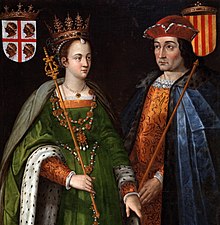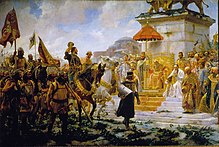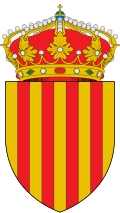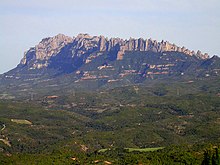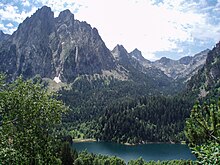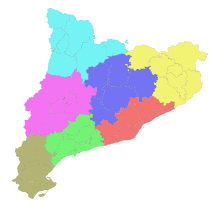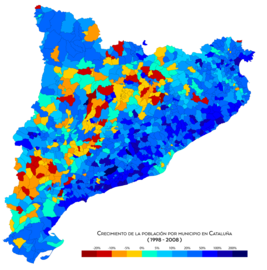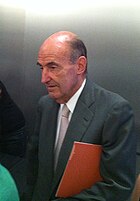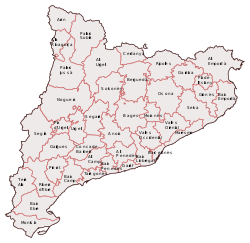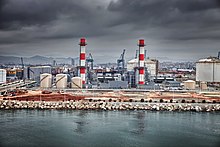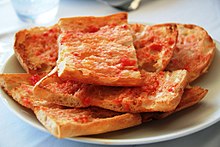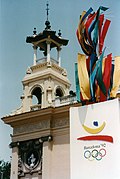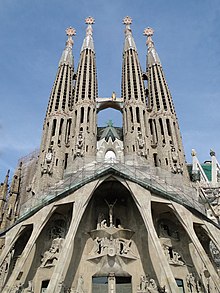Catalonia
Catalonia (in Catalan, Catalunya; in Aranese, Catalonha) is a Spanish autonomous community, considered a historical nationality. Located in the northeast of the Iberian Peninsula, it occupies a territory of about 32,000 km² that limits to the north with France and Andorra, to the east with the Mediterranean Sea along a maritime strip of about 580 kilometers, to the south with the Valencian Community (Castellón) and to the west with Aragón (Teruel, Zaragoza and Huesca). This strategic situation has favored a very intense relationship with the territories of the Mediterranean basin and with continental Europe. Catalonia is made up of the provinces of Barcelona, Girona, Lérida and Tarragona. Its capital is the city of Barcelona.
As of 2019, 7,675,217 people inhabit Catalonia in a total of 947 municipalities, of which only 64 exceed 20,000 inhabitants (in where more than 70% of the Catalan population lives). Two thirds of the population live in the metropolitan area of Barcelona. It constitutes a territory with a high population density and highly industrialized, whose economy is the second among the autonomous communities, generating 19.0% of the Spanish gross domestic product (GDP), only surpassed by the Community of Madrid. Regarding GDP per capita, it is in fourth position, after the Community of Madrid, the Basque Country and Navarra.
According to data from the Valencian Institute of Economic Research from 2007, its human development index (0.958) is the eighth highest in Spain, behind La Rioja and ahead of Asturias. The social services development index places it in eighth position, behind Castilla-La Mancha and Cantabria. In the PISA report it ranks seventh in reading (500 points), and sixth in mathematics (500 points) and sciences (504 points), unless of a 5% distance from the first autonomous community (Castilla y León and Navarra).
Toponymy
A manuscript from Al-Udri (before 1085) is documented referring to Talūniya, which could be an indication of the toponymic origin of the area. The origin of the word Catalonia remains uncertain, although several possibilities have been pointed out. The place name as such is found for the first time in written form around 1117 in the Latin form that appears in the Pisan poem Liber maiolichinus de gestis pisanorum illustribus . In that text, which describes the deeds that the Pisans carried out with the Catalans to approach the conquest of Majorca, there are several references to Count Ramón Berenguer III (Dux Catalanensis, Rector Catalanicus hostes, Catalanicus heroes , Christicolas Catalanensesque) as well as ethnic references such as catalanenses or catalanensis and their territory, Catalonia. Subsequently, the expression in Catalonia also appears in some donations that King Alfonso II made to his wife in 1174, as well as on various occasions (Cathalonia) in the will of the king and in songs of Occitan troubadours (Catalonha). its scope of validity: Haec est pax quam dominus Petrus (...) constituit per totam Cataloniam, videlicet a Salsis usque ad Ilerdum. The first time it appears in Catalan is in the Llibre dels fets of James I the Conqueror, in the second half of the 13th century.
However, the reason for this name is unclear. Some postulate that the word comes from Gotholandia (country of the Goths) through Gothia or Gotia, which was how the Franks also called the Brand Hispanic, due to the presence of the Visigothic population in Septimania and the north of present-day Catalonia after the fall of the Visigothic kingdom, although the phonetic transformation is debatable. Similarly, Gothoalania (country of Goths and Alans) is suggested, despite there being no references to this second town in Catalan territory. A medieval historian, Pere Tomic, suggests the existence around the 8th century of a German knight named Otger Cathaló , to whom Charlemagne dedicated his name to the southern lands due to his conquest deeds of the Pyrenees. This theory is collected by Pedro de Medina in his Book of Greatness and Memorable Things of Spain published in Seville in 1548.
Another proposal suggests that for the defensive needs of the March many fortifications were built. Its guards were the castellanos that in medieval Low Latin would take the name of castlanus from whose voice the Catalan forms castlà, catlà and carlà. In these ways, foreigners who passed through their lands would have begun to name the inhabitants and their territory that way (català > Catalonia, Catalaunia), so Catalonia would mean "land of castles". However, this explanation has been questioned due to phonetic difficulties. Modern authors such as Ronjat (Grammaire historique des parlers provençaux modernes) and Grammont (Sur la métathèse) defend that the place name comes from an alteration of the Latin referring to the lacetans (LACETANI). The transformation would occur by metathesis between the -l and the -c: lacetanos > catelanos > catelans. This process must have occurred among the popular layers and in remote times, prior to any scholarly influence. Currently, this etymology and the one referring to the Goths are the most widespread. In addition to those discussed there are even more lesser-known etymological proposals. For example, both Catalan and Castilian could derive from a fusion of the Gothic words guta and athala, with the meaning of "noble goth", or "noble goth". In this sense, Otger Cathaló could be Otger the noble Goth.
An interpretation that arose in the XV century, discarded among others by Antonio Agustín and described as absurd by Félix Torres Amat, It intends to derive the name of Catalonia from the Campos Cataláunicos. According to this, the name derives from the title Catalaunicus of the Visigothic king Turismundo, whose dynasty came to dominate territories on both sides of the Pyrenees. Said titling has its precedent in the following events: On June 20, 451, in the Catalaunic Fields (region of the Gallic Catalauni tribe, which may be linked to the Celtic-Belgian tribe of the Catuvellaunos, mentioned by Dion Casio) whose terminology gives the name to the city of Châlons (Chatalan) and to Champagne (Champs), a great battle occurred between Attila's Huns (with their allies Ostrogoths, Gepids, and Héruli), against the Romans of Flavio Aecio (with his Visigoth and Alano allies), where more than twenty thousand warriors died. In this battle, Attila, leading his horsemen, attacked the Alans from the center, and the Ostrogoths attacked the Visigoths from the right, while the Gepids and Heruli attacked the Roman soldiers of Aetius from the left, who They dominated a hill. In the combat, the Visigothic king Theodoric I perished, for which his son Turismundo was named king in the middle of the combat, to later provoke the rout of the Ostrogoths and incline the combat against Attila's confederation, which was also forced to withdraw.. After the battle, the Visigothic king Turismundo returned to his capital Toulouse, where as a result of that victory, Turismundo was named king Catalaunicus, which was the germ of the future Catalan denomination and of Catalonia. Pyrenees.
Symbols
Catalonia boasts various symbols that are more or less widespread among its inhabitants, some of which have been made official. Article 8 of the current Statute of Autonomy defines the flag, the festival and the anthem as national symbols. Several Catalan laws also declare these symbols as national:
- The flag is "the traditional one of four red bars in a yellow background", whose origin is in the royal pendant of the kings of the Crown of Aragon, head of the Principality of Catalonia.
- The party is the Eleventh Day of September, also known as the Day of Catalonia or Diada, which commemorates the fall of Barcelona in front of the Bourbon troops.
- The hymn is Los Segadores, whose original letter is 1899, although it is based on a popular romance of the centuryXVIIduring the uprising of Catalonia.
In addition, it has other unofficial symbols, such as the shield.
The Catalan donkey is a bet of a nationalist citizen sector that arises in response to the Osborne bull. In the cultural field, the Catalan language and the arts are representative of Catalonia, as well as in the folklore, the sardana stands out, the dance of devils and the correfocs, the giants and big heads and the castells.
The regional government has also made its own symbol official, called the emblem of the Generalitat of Catalonia, which is used in all institutional representations.
History
After the disintegration of the Carolingian Empire, the county of Barcelona, which had formed part of the Spanish March of the Empire, achieved de facto independence at the end of the 10th century and was able to unite around it, through family ties or vassalage, to an important part of present-day Catalonia, mainly the counties of Gerona, Osona, Besalú, Cerdanya and Ampurias. In the 12th century, the county of Barcelona and the kingdom of Aragon were dynastically united through the betrothal agreed between Ramiro II of Aragon and Ramón Berenguer IV of Barcelona in 1137, whereby the Barcelona count would marry the future Aragonese queen Petronila. In the fourteenth century, it had a prominent economic role in the framework of Mediterranean trade. With the decline of the Crown of Aragon, Catalonia declined, which did not prosper again until industrialization.
In the first third of the XIX century Spain was invaded by Napoleon Bonaparte. Barcelona is occupied by the French and Tarragona becomes the electoral capital of the Catalan deputies, who are part of the Parliament of Cádiz, and participate in the first constitution of the Spanish nation, in the year 1812. From the second third of the The XIX century saw the development of the Renaixença, a cultural movement to recover Catalan as a language of culture. In the decades that followed, political Catalanism took shape, grouping itself into parties such as the Lliga Regionalista and later Esquerra Republicana. After the first self-government projects that culminated first in the Commonwealth of Catalonia (1913-1923) and then in the restoration of the Generalitat of Catalonia and approval of the Statute of autonomy of Catalonia in 1932 during the Second Republic, the Civil War and the period Franco regime (1939-1975) meant, both in Catalonia and in the rest of Spain, the annulment of political freedoms, in addition to the prohibition of Catalan in the official and educational spheres, which were not fully recovered until the democratic Transition and the Entry into force of the new Spanish Constitution of 1978, which recognizes the existence of autonomous communities within Spain. Under the Constitution, a new Statute of Autonomy was approved in 1979 that recovered the official use of Catalan, later replaced by the 2006 Statute, which after some modifications issued by the Constitutional Court in 2010, due to its unconstitutionality, is currently the current.
Geography
Catalonia has a relatively marked geographical diversity, taking into account its relatively small territory. The geography is conditioned by the Mediterranean coast to the east, with 580 kilometers of coastline, and the large relief units of the Pyrenees to the north.
Geology
The current geological state of Catalonia can begin to be described from the first great changes of the Paleozoic. Initially, the territory was part of an oceanic basin in which, due to orogenic rest, fine and clayey sedimentary materials were deposited. The development of Hercynian folding determined a more irregular sedimentation that later produced the emergence (low height) of several areas with a northwest-southeast orientation, such as the Ebro massif (current central Catalan depression) and the Catalan-Balearic massif, which arose at the end of the was. The sedimentary materials of the time were transformed into gneiss, schist and slate that emerge today in the northern half of the coastal ranges and the axial Pyrenees.
The Mesozoic era covered again the areas emerged during the previous era, which caused a calm sedimentation under the sea, generating a large amount of calcareous material. Today this material is found in the southern half of the coastal ranges and in the Pre-Pyrenees.
At the beginning of the next era, the Cenozoic, the Eurasian and African tectonic plates make contact and a back of folds and mountain ranges begins to rise gently through alpine orogeny that will give rise, among others, to the Pyrenees. This push also affects the movement of the Catalan-Balearic massif towards the Southwest, covering the Ebro massif, still submerged, which is causing the deposit of materials that will give rise to the future Catalan central depression. Conglomerates deposited by the rivers accumulate along the coastline and give rise to the outstanding elevations of the Montserrat, Sant Llorenç del Munt, etc. massifs. Meanwhile, towards the interior of the basin, sand and clay accumulate that will give rise to stoneware. When the Ebro massif closed, in the shape of a gulf, a large salt lake was created. Its waters were exposed to intense evaporation that eventually gave rise to large saline deposits from which salt was still extracted until recently in Súria and Cardona. The second half of the era eroded a large part of the Catalan-Balearic massif due to decompression, remaining in a narrow line that makes up the pre-coastal depression, the Cerdanya plain, the Empordà, etc. At the end of the period, the alpine movements affect the emergence of volcanoes in the Olot area that will last until the Quaternary and the glaciers of the Pyrenees end up shaping the territory.
Orography
The relief of Catalonia presents, roughly, three large general morphostructural units: the Pyrenees, the mountainous formation that connects the Iberian Peninsula with the European continental territory and is located to the north of Catalonia; another unit formed by an alternation of elevations and plains parallel to the Mediterranean coast, called the Catalan Mediterranean System or Catalan Coastal Ranges and a last structural unit located between the previous ones called the central depression that configures the eastern sector of the Ebro Valley.
The Catalan Pyrenees is almost half the length of the entire Spanish Pyrenees, as it is distributed over more than 200 kilometres. Traditionally, the Axial Pyrenees, the main one, has been differentiated from the Pre-Pyrenees (southern in the Catalan territory) and that they are mountainous formations parallel to the main sierras, although they are lower in altitude, less steep, and of a different geological formation. Both units are wider in the western sector than in the eastern, and it is there where they present their highest peaks. The highest elevation in Catalonia, which is located north of the Pallars Sobirá region, is the Pica d'Estats with 3143 m of altitude. Along the border with France, it is followed by Puig Pedrós with 2,914 m and Puigmal with 2,910 m. The Besiberri massif reaches 3029 m. Of the Pre-Pyrenees, several mountain ranges and peaks stand out, such as the Sierra del Cadí (Vulturó, 2,648 m) or that of Pedraforca (Pollegó Superior, 2,497 m).
The Catalan Mediterranean System is based on two mountain ranges that are more or less parallel to each other and to the sea following a northeast-southwest orientation and they are the Coastal Mountain Range, the closest to the sea, and the Pre-coastal Mountain Range behind the previous one. The Coastal Cordillera is less extensive and lower in altitude (Turó Gros, Sierra del Montnegre, 773 m) while in the Pre-coastal the range is broader and higher in altitude (Turó de l'Home, 1706 m). Within the system there is a series of flat lands, whose major entities form the Coastal Depression and the pre-coastal depression. The Coastal Depression is located on the edge of the coast and is prior (except for some sectors) to the Coastal Cordilleras. The pre-coastal depression is located in the interior, between the two coastal ranges, and constitutes the base of the flat lands of Vallés and Panadés. Other larger plains are the Depresión de la Selva and the Llano del Ampurdán, mostly in the regions of La Selva and Ampurdán respectively. Finally, the System also includes the Transversal Cordillera, which are late formations to the north of the Pre-coastal Cordillera and in contact with the Pyrenees and Pre-Pyrenees, thus originating medium altitudes and volcanoes in the Garrocha area that are now extinct.
The central Catalan depression is a plain located between the Pre-Pyrenees and the Pre-coastal Mountain Range. The southern regions of the province of Lérida and the central ones of Barcelona occupy this territory. Its lands are located between 200 and 600 meters of altitude in a continuum from west to east, although it has some intermediate foothills. The plains and the water that comes down from the Pyrenees have transformed this area into large cultivated fields where numerous irrigation canals have been built.
Climate
Catalonia enjoys a Mediterranean climate, although with great variations in temperature between the coastline, with a mild climate, temperate in winter and very hot in summer; the interior that has a Mediterranean continental climate, with cold winters and very hot summers; and the mountainous areas close to the Pyrenees, which have a high mountain climate, with low temperatures below zero and abundant snow in winter, annual rainfall above 1,000 mm and less hot summers.
Hydrography
Catalonia belongs almost entirely to the Mediterranean basin. The Catalan hydrographic network has two major hydrographic basins, the Ebro hydrographic basin and the internal basins of Catalonia of a similar size over the territory (15,038 km² —46.84%— and 16,513 km² —51.43%— respectively)., both pouring into the Mediterranean, which is accompanied by the Garonne basin which pours its waters into the Atlantic and extends over 554 km², 1.73% of the Catalan territory.
The Ebro basin in Catalonia is mainly served by the Segre river as its largest tributary, whose basin alone reaches 7,455 km², and to which the Noguera Pallaresa (2,811 km²) and Noguera Ribagorzana (2,811 km²) basins are added as tributaries. 1013 km²). All the rivers follow a Pyrenees-Ebro axis. After the influx of the Segre, the Ebro heads towards the Delta, irrigating a territory of 3,757 km² through other tributaries, largely located in the Tierras del Ebro area.
The internal basins of Catalonia are usually divided into those rivers that originate in the Pyrenees and those that do so in the Catalan Coastal Ranges. The basins that make up the Pyrenees-Mediterranean axis are made up of the Llobregat, Ter, Fluvià, Muga and Tec rivers (which runs towards Roussillon). These basins cover an area of 9,622 km². The remaining basins, following the so-called Mediterranean axis, are born both in the Coastal Range, Pre-coastal and in the Plain of Ampurdán and irrigate its waters for 6890 km². The most important rivers are (from north to south) the Daró, Tordera, Besós, Foix, Gayá, Francolí and Cenia.
The smallest of the Catalan basins, that of the Garona River, runs mainly through the Aran Valley. It receives water from numerous rivers and ravines that flow down the slopes of the valley's mountains, and within Catalan territory its longest tributaries are the Unhòla river, the Nere river and the Varradòs river.
The Ebro basin provides an average of 18,700 hm³ per year, while the internal basins only have 2,020 hm³ per year. The imbalance is caused by the previous contribution of the Ebro (around 6,700 hm³/year) to which is added the Pyrenean contribution of the Segre (around 12,000 hm³/year) towards the south of the province of Lleida. It is around the regions of the central depression that these waters have been used to build numerous irrigation canals. The Urgell Canals (478 hm³), the Aragón and Cataluña Canal (362 hm³) and the future Segarra-Garrigas Canal (342 hm³) stand out. However, despite its reduced flow, of all the Spanish basins, it is from the Internal Basins of Catalonia where water is used the most for human consumption (518 hm³). This imbalance has promoted the use in the coastal and eastern regions of groundwater, of which Catalonia has plenty of reserves. In any case, it is common that in periods of low rainfall there are cuts in the supply to populations, even in spring. For this reason, various options for river transfers have been considered. There are 28 reservoirs for water supply, ten of which work in the Segre basin. The oldest is that of Camarasa, built in 1920, and the largest are those of Canelles (679 hm³, shared with Aragón), Rialb (402.8 hm³), Santa Ana (236.6 hm³, shared with Aragón) and Susqueda (233 hm³).
There are few sizeable lakes in the territory. Most of them are found in the Catalan Pyrenees in the form of small lagoons (estanys), originated by old glacial cirques. Of these, the Aigüestortes and San Mauricio Lake National Park are famous, although the largest of all is the Banyoles Lake, of karstic origin.
Coast
The Catalan coast is seen by a general line of more than 500 km in length, although in definition it reaches 754.8 km. The coast tends to be rectilinear without major accidents. The only maritime accidents are configured by the contact of the Pyrenees with the sea, forming Cape Creus, next to which is the Gulf of Roses. Subsequently, and up to Blanes, the Costa Brava appears, characterized by low cliffs and hidden coves. Then follows a long line of Maresme beaches, parallel to the Coastal Range, and which is only intersected by the various commercial and fishing ports. The coast of Barcelona is characterized by artificial beaches and a large commercial port that stretches for more than nine kilometres. The southern part of the port was developed on the plain of the Llobregat delta, which after the port draws a gentle coastline of just over 18 km. Then the Garraf massif articulates the coasts in remarkable cliffs and until after Sitges the coast is not rectilinear again (with the exception of numerous ports) and oriented towards the south, up to the height of the port of Tarragona. This is the second largest port in Catalonia and stretches for more than five kilometres, before entering Cape Salou. The beaches in this area take the name of Costa Dorada in its tourist aspect. To the south the coast is smooth again, and is characterized by less human occupation. The last great geographical feature is determined by the Gulf of San Jorge and the lowlands of the Ebro delta, where islands and peninsulas are found, such as those of Punta del Falgar to the north and La Banya to the south, which is linked to the delta by the Trabucador beach. The sand on Catalan beaches is generally golden, with a certain tendency to be grainy to the north and finer to the south.
Land uses
| Map of Catalonia by land use in 2002 |
|---|
 |
| crop cultivation continental waterssandals, snows and other unproductive soilsurban, industrial and forests, clear and wet vegetation |
Despite the population and industrialization of Catalonia, a good part of the soil remains intact by man. The forest landscape is distributed over 18,257 km² (2002), and is especially appreciated in the mountainous areas of the north and the coast. This includes light and dense forests (sclerophyllous, deciduous, and needle-like) as well as wetland vegetation. These forests occupy 56.8% of the Catalan surface. By extension, the following cover is occupied by crops, extending over 32.5% of the territory (10,448 km²). Of these, dry farming (7,069 km²) stands out, spread over many regions and being characteristic of Segarra, Solsonés, Bages and Noya, among others. The dryland fruit cultivation extends mainly from the south of Ponent and the Tierras del Ebro. Regarding the vine, the vines extended that year for 769 km², mainly in Panadés. The extension of irrigation is more restricted (2,611 km²) and is distributed mainly through the Segriá, Plana de Urgel and surroundings, especially through the numerous irrigation channels, as well as the Ebro delta, and to a lesser extent, in the Ampurdán, La Cerdanya and on the coast of Barcelona. The cultivation of fruit trees by irrigation is less extensive, and occurs especially in Segriá and Campo de Tarragona.
In 2002, human presence covered an area of 1,520 km² (4.7% of the Catalan territory) and is generally concentrated on the coast, especially in the Barcelona metropolitan area. The extension of the urbanizations stands out, greater than that of the urban centers, and later the area destined for industrial and commercial use (229 km²).
Finally, the unused or unusable land constituted 5.4% (1740 km²) and extended mainly along the Pyrenean peaks in the form of grass or meadow vegetation. The surface occupied by water (from rivers, lakes or dams) was 150.5 km², only 0.5% of the Catalan surface.
Protected spaces
The protection of the Catalan natural environment has grown rapidly in recent years. As of 2006, the protected land territory amounted to 9,608 km², practically 30% of Catalonia. The spaces differ in degree of protection; In this sense, the park with the greatest rank and age is the only national park in Catalan territory, the Aigüestortes i Estany de Sant Maurici National Park, inaugurated in 1955. However, it was already from 1932 that it was intended to protect some spaces from the Pyrenees in the so-called Plan Macià.
It was not until after the restoration of democracy and the autonomous government that legislation was passed to protect natural spaces. Currently, there are several administrations (the Ministry of the Environment, the Generalitat of Catalonia and the Barcelona Provincial Council, together with various consortiums of municipalities) that are in charge of monitoring, protecting and promoting protected areas. The Generalitat, in addition to co-managing the Aigüestortes Park, manages a network of eleven natural parks, three Natural Areas of National Interest, a nature reserve (Delta del Llobregat) and a marine reserve (Medas Islands). For its part, the Barcelona Provincial Council has a Network of Natural Parks (Xarxa de Parcs Naturals) managed by the Provincial Council's Area of Natural Spaces that extends the protected spaces by 12 parks with different degrees of protection, some managed together with the Generalitat. In addition to these parks, there is a more extensive network of specific spaces protected by less specific laws whose objective is to combine the diversity of the Catalan territory and its local flora and fauna. This network, called Plan de Espacios de Interés Natural (PEIN) also incorporates the aforementioned natural and national parks that do have specific legislation. As of April 2007, the spaces included in the PEIN amounted to 165.
Demographics
The population of Catalonia on January 1, 2015 was 7,504,008 inhabitants, with a percentage of people of immigrant origin of 14.49%.
The city of Barcelona is home to more than 1.6 million people in just over 100 km² of surface area.
Around the capital there are two and a half million more people who reside within a radius of less than 25 km from the capital. In the first metropolitan ring are the cities of Hospitalet de Llobregat, Badalona and Santa Coloma de Gramanet. The main towns of the second crown are Tarrasa, Sabadell, Mataró, Moncada and Reixach, Granollers, Martorell, Molins de Rey, San Feliú de Llobregat, Gavá and Castelldefels. A population of over four million inhabitants is concentrated in the metropolitan area of Barcelona. The second urban agglomeration in Catalonia is the one formed by the Reus-Tarragona agglomeration.
The rest of the population of Catalonia is divided into the north coast (Costa Brava), the south coast (Costa Dorada), the Llobregat river valley up to Manresa, and the inland cities of Lleida (to the west) and Gerona (northeast).
Government and politics
Catalonia, organized as an autonomous community, is defined as a nationality in its Statute of Autonomy, under the provisions of the second article of the Spanish Constitution, which recognizes and guarantees the right to autonomy of the nationalities and regions that make up Spain.
Public administrations
There are four public administrations in Catalonia, with different levels of responsibility and political powers: the General State Administration, the Generalitat of Catalonia, the provincial councils, and the town halls.
The General State Administration deals with different issues such as security (armed forces), justice, port and airport management, RENFE trains, and the coasts, among the most important powers. Over the last few years, the National Police Corps and the Civil Guard, within the framework of the transfer of powers, have been relieved of most of their powers due to the progressive deployment over the territory of the Mozos de Escuadra, regional police. The State Administration in Catalonia is coordinated from the headquarters of the Government Delegation. The Government Delegate is directly appointed by the Government of Spain by decree.
The Generalitat of Catalonia, the institutional system in which the self-government of Catalonia is politically organized, has broad powers and manages different areas, such as: education, social affairs, transit, determination of economic and trade policies, etc. The Generalitat is also responsible for the construction of public facilities such as hospitals, primary and secondary schools, universities, residences for the elderly, among others.
Self-government
Catalonia, like other Spanish autonomous regions, has extensive powers transferred by the State. Currently, the Generalitat has powers in matters such as culture, tourism or housing. In other areas, such as credit management, banking and insurance, it is responsible for legislative development and the execution of basic State legislation. Finally, in matters such as intellectual and industrial property, it is responsible for the execution of state legislation.
Tax regime
Unlike the Basque Country and Navarra, whose tax relations with the State are regulated by their respective traditional foral systems, and the Canary Islands, Ceuta and Melilla, for which the organic law provided for in article 157.3 of the Constitution, of financing of the autonomous communities, establishes peculiarities, Catalonia, like the remaining communities, lacks a special fiscal autonomy. Most of the taxes are collected by the State Tax Administration Agency, so its income depends on the transfers it receives from the central Administration.
Political system
In 1931 there was a first establishment of a self-government for Catalonia, which disappeared after the Spanish civil war of 1936-1939. Subsequently, in 1977 with the approval of the Spanish Constitution, Catalonia was granted the capacity for self-government in some matters. As of that date, the Parliament of the Generalitat, the Presidency of the Generalitat and the Government of the Generalitat, which are its main self-government institutions, as well as the rest of the bodies created by law of the Catalan Parliament, are created.
- Executive branch of Catalonia
In the Catalan territory, in addition to the Spanish Government, it exercises its executive powers, the Catalan Government is made up of the President of the Generalitat, the first counselor, if applicable, and the counselors. It exercises the executive function and regulatory power.
- Legislature of Catalonia
The Parliament of Catalonia is made up of one hundred thirty-five deputies, elected for a term of four years by universal, free, equal, direct and secret suffrage. Parliament exercises legislative power, approves the budgets of the Generalitat and controls and promotes political and government action.
- Judiciary in Catalonia
According to the provisions of article 152.1 of the Constitution, the Superior Court of Justice of Catalonia culminates the judicial organization in the territorial scope of Catalonia.
Under the provisions of the Statute of Autonomy, Catalonia is governed by Catalan civil law, the conservation, modification and development of which is the exclusive responsibility of the Generalitat. Likewise, in accordance with article 35 of the Statute of Autonomy, a law of Parliament regulates the figure of the Ombudsman (equivalent to the Ombudsman), who watches over the defense of the fundamental rights and public liberties of citizens in their relations with public administrations.
Political formations

The main political formations in Catalonia —political parties, candidacies and coalitions— present in the Parliament of Catalonia, are the following:
- The Citizen-Party Party of Citizenship, born from the civic and cultural platform Ciutadans de Catalunya;
- The joint list of Junts per Catalunya (“Juntos por Cataluña”), consisting of the Catalan European Democratic Party (PDeCat) and the Democratic Convergence of Catalonia (CDC).
- The Republican Esquerra coalition of Catalonia-Catalunya Sì (“Republican Left of Catalonia-Cataluña Yes”), composed of Republican Esquerra de Catalunya (ERC), Reagrupament Independentista (RI) and Catalonia Yes (CAT-SI).
- The Socialist Party of Catalonia, an independent party and associated with the Spanish Socialist Workers Party, formed after the merger of the three regional socialist parties existing during the Transition: Socialist Party of Catalonia-Congrés, Socialist Party of Catalonia-Reagrupament and the Catalan Federation of PSOE;
- The Catalonia coalition in Comú-Podem (“Catalonia en Común- Podemos”), composed of Catalonia in Comú, Barcelona in Comú, Initiative per Catalunya Verds, Esquerra Unida i Alternativa, Podemos and Equo;
- The Candidacy of Popular Unity-Constituent Call, of which members are Candidature of Popular Unity, Drassanes Collective, Constituents for the Rupture, Internationalist Fight, In Fight, Red Current, Els Verds-Alternativa Verda, Endavant, Poble Lliure, Arran, Student Union of the Catalan Countries, Local Workers Coordinator and various parties of the Catalan Countries
- The Popular Party of Catalonia, the Popular Party delegation in the Catalan Autonomous Community.
The controversy of Catalonia as a nation
In the proposal for the Statute of Autonomy approved in 2006 and currently in force, the Parliament of Catalonia approved the definition of Catalonia as a nation. However, exercising its superior powers, the Congress of Deputies amended that proposal and excluded the definition of "nation" in the articles of the new Statute -although a reference is maintained in the preamble to what the Catalan Parliament approved in its day, as follows: "The Spanish Constitution, in the second article, recognizes the national reality of Catalonia as a nationality." Likewise, the Catalan legislators introduced another reference to the national character of Catalonia, protected by the current legal system, which is found in article 8.1 of the 2006 Statute, by stating that Catalonia, defined as a nationality in article 1, has as «symbols nationals» the flag, the festival and the anthem.
In the opinion of the National Government, and the ruling party that supported its approval, the text of the preamble only has declarative value and not legal value. In the opinion of the spokesperson for the Socialist Parliamentary Group, in his speech, on behalf of the ruling party, during the debate in the Congress of Deputies on the Statute, the preamble has "political, legal and interpretive importance". The Popular Party, at that time then the main opposition party, filed an appeal before the Constitutional Court on July 31, 2006 against the new Statute for the possible unconstitutional use of the term "nation" in the preamble —among many other aspects—, which was admitted for processing by the High Court and that it was resolved declaring the Statute partially unconstitutional. The Ombudsman did the same on September 19 of the same year.
Unilateral Declaration of Independence (DUI)
On October 27, 2017, the Parliament of Catalonia voted to convert Catalonia into a Republic, in a secret ballot and with the absence of the 53 deputies from the parties opposed to the independence process —PP, PSC and Ciudadanos— considering that the Spanish Constitution does not allow it. It was a vote against the decisions of the Constitutional Court and the Parliament's own lawyers, who previously warned the Board that they could not formalize any resolution in this regard in accordance with current legislation and the opinions of the Constitutional Court. The motion goes ahead by seventy votes in favor, ten against and two blank, but said declaration of independence is temporarily suspended by the Constitutional Court on October 31 following a petition in this regard from the PSC.
On the afternoon of October 27, the Senate approves the Government's request to activate article 155 of the Constitution by 214 votes in favor, 47 against and one abstention, alleging the repeated violation of the Catalan Government of the laws in force in their desire for sovereignty. The Spanish Government dismisses the Catalan Government, calling elections for December 21, 2017, and passing the work of the ministries to those of the corresponding ministries. All the political parties end up accepting the call for elections, even the Catalan nationalists despite their initial reluctance. He also takes control of the Mozos de Escuadra, the Catalan regional police, dismissing Major Trapero due to his legal problems, and puts his number two in command. The decision is accepted without incident by the members of the autonomous police force.
On October 30, the State Attorney General requests that charges for sedition, rebellion and embezzlement be charged against the Parliament Board and the Government of the Generalitat. The latter, allegedly for embezzling public funds to finance the referendum declared illegal by the Constitutional Court that took place on October 1 of the same year.
The former president of the Generalitat, Carles Puigdemont, fled to Belgium along with four former councilors with the intention of internationalizing the problem, [citation required] After accepting the complaint by the State Attorney General, the judge of the National Court, Carmen Lamela, summons the dismissed members of the Catalan Government for November 2. Due[citation required] to the flight of Puigdemont and other directors, after appearing in court, he declared unconditional imprisonment for the Catalan vice president Oriol Junqueras and seven other former directors for crimes of sedition, rebellion and embezzlement. The complaint to the Bureau of Parliament is presented to the Supreme Court for being registered members and is accepted, but its declaration is postponed from November 2 to 9 of the same month.
Finally, Judge Lamela refers the open case to the Supreme Court, assessing that the defendants are part of the same investigation conducted by Judge Pablo Llarena in the High Court, but retains the investigation into the development of the independence referendum of the October 1, 2017, also considered unconstitutional.
Territorial organization
Catalonia is organized territorially into counties, municipalities and provinces. Historically, it has also been organized into regions and veguerías, the latter name being recovered with the new Statute of Autonomy.
Provinces
The provinces are the oldest administrative division still in force in Catalonia. They start from the group of municipalities and take the name of their capitals. The Judiciary starts from the provincial division to establish the judicial districts, grouping the municipalities that are adjudicated under the same judicial headquarters. The autonomous community of Catalonia arose through the formal union of four provinces:
|
Country
The Generalitat of Catalonia established an administrative division into forty-one counties, the governing bodies of which are the County Councils. The regional division of Catalonia has its origin in a decree of the Republican Generalidad of 1936, which was in force until the end of the Civil War. The county division was again adopted by law of Parliament in 1987. This division was based on geographic and local market criteria, which largely coincides with previous territorial entities with a long tradition. There are only four counties (Bergadá, Cerdaña, Osona and Selva) that include municipalities belonging to two provinces, while the rest do so fully maintaining the same municipal borders.
The Aran Valley deserves special attention since, although it is included within the regional organization, it enjoys greater autonomy, in accordance with Law 16/1990, on the special regime of the Aran Valley, approved by the Parliament of Catalonia.
Municipalities
The municipality is the territorial base of Catalonia where there are 947, of which as of 2017 (INE), 488 had less than 1000 inhabitants. 121 exceed the population to be considered a city, and 64 exceed 20,000 inhabitants (in which more than 70% of the Catalan population lives).
Economy
Catalonia is a territory with an industrial tradition since the 19th century. Industry, tourism and services are currently the main economic sectors in Catalonia. Average annual growth for the period 1995-2004 in real terms was lower than the Spanish average. In 2014, the Catalan economy grew by 1.4%, the same percentage as the Spanish average and above the European average. According to the same official sources, Catalonia is in fourth place in the classification of communities according to GDP per capita in Purchasing Power Parities and is the one that contributes the most to the total Spanish GDP (18.7%, year 2014).
The unemployment rate in Catalonia at the end of 2014 was 19.9%: 20.2 for men and 19.6 for women.
Industry, construction, tourism and services are the main economic sectors of Catalonia.
Catalonia is the number one tourist destination in Spain: the 16.7 million tourists it received between January and December 2014 represent 25.8% of the total arrivals registered throughout Spain, and represent an increase of 7, 2% compared to the same period of the previous year. The main tourist destinations in Catalonia are the city of Barcelona, the beaches of the Costa Brava in Girona and the Costa Dorada in Tarragona (where the PortAventura World tourist complex is also located), and the Pyrenean area, where there are 10 ski resorts: Baqueira Beret, La Molina, Espot Esquí, La Masella, Port Ainé, Vall de Núria, Boí Taüll, Port del Comte, Rasos de Peguera, Tavascan and Vallter 2000.
Housing is the biggest source of debt for Catalans. In this sense, it should be noted that Catalonia is, after Madrid, the second community in Spain where the price of housing is most expensive: an average of 3,397 euros per square meter is paid, according to data from the Valuation Society as of December 31, 2005. By cities, however, Barcelona is the most expensive city in Spain, with an average price of 3,700 euros per square meter.
From a financial point of view, it is worth highlighting the great implantation and tradition that savings banks have in Catalonia, greater even than private banks. An example is that of the 46 Spanish savings banks, 10 are Catalan. Particularly noteworthy are the Caja de Ahorros y Pensiones de Barcelona, known as laCaixa, which is the leading savings bank in Europe, and Caixa Catalunya. As for banks, the most important in Catalonia is Banco Sabadell, the fourth Spanish banking group.
The Barcelona Stock Exchange, which in 2014 traded almost 212,825 million euros, is the second most important in Spain after the Madrid Stock Exchange. In 2018, the contracting volume was 166,994 million euros.
For its part, the Barcelona Fair organizes all kinds of international exhibitions and congresses on various sectors of the economy.
Energy
The production of electrical energy is of great importance in the community. The bulk is in charge of the thermal and nuclear power plants present in it:
Fossil fuel power plants
| Name | Municipality | Province | Type | Groups | Power | Owner |
|---|---|---|---|---|---|---|
| Thermal center of the Port of Barcelona | Barcelona | Barcelona | c. combined | 2 | 850 MW | Gas Natural Fenosa |
| Thermal central Besos V | San Adrián de Besós | Barcelona | c. combined | 2 | 873 MW | Endesa |
| Combined Besos Cycle Centre | San Adrián de Besós | Barcelona | c. combined | 2 | 800 MW | Gas Natural Fenosa / Endesa |
| Central thermal Tarragona Power | The Canonja | Tarragona | c. combined | 1 | 424 MW | Iberdrola |
| Thermal plant Vent | Vandellós | Tarragona | c. combined | 2 | 800 MW | Gas Natural Fenosa / Alpiq |
Nuclear thermal power plants
- Ascó nuclear power station in Ascó, Tarragona.
- Vandellós nuclear power station in Vandellós, Tarragona.
Conferences and exhibition halls
In Catalonia a large number of congresses and exhibition halls are organized which, only in the Fira Barcelona located in Barcelona and Hospitalet de Llobregat, receive the visit of more than 3 million people.
Infrastructures and services
Citizen security
Catalonia has its own autonomous police force, called Mozos de Escuadra, under the provisions of the Law on Security Forces and Corps. The Mozos de Escuadra were gradually replacing the State security forces and bodies, the Civil Guard and the National Police Corps, which report directly to the Ministry of the Interior, with the Catalan regional police assuming public security powers, which include some of the functions that both the Civil Guard and the National Police had been performing up to now, mainly in matters of citizen security and traffic. Once the deployment has finished, the State maintains in Catalonia a limited number of agents to carry out the functions attributed exclusively to the General State Administration, such as terrorism and drug trafficking, surveillance of ports, airports, coasts and borders, customs, control of entry and exit of the national territory, general regime of foreigners, extradition and expulsion, emigration and immigration, official identity documents, arms and explosives trafficking, fiscal protection of the State, smuggling and fiscal fraud and the other functions that the Constitution and the law establish.
Transportation
It is worth noting about transport in Catalonia the integrated fare system used in public transport in all its provinces. The T-Mobilitat will be the latest advance in transport integration, allowing the citizens of Catalonia to use a single ticket for all the adhered modes of transport that are currently divided into four different integrated systems.
Culture
Science
Scientific and technological research has been one of the pillars of Catalonia's development. Among the most famous Catalan scientists, mention should be made of Narciso Monturiol, the astronomer José Comas y Solá, the climatologist Eduard Fontserè, and the biochemist Joan Oró.
Currently, a large economic investment is being made by public administrations and private entities to maximize scientific and technological research, not only in university centers but also in private institutions. In this area, the work of institutions such as the Higher Council for Scientific Research in Catalonia stands out.
In this sense, it is worth noting the upcoming inauguration of the Biomedical Research Park that is being built in Barcelona, and which will be the most important in Europe in the biomedical field; the 22@ neighborhood project in Barcelona, which encourages the installation of all kinds of leading companies in the European technological field; and the start-up with the inauguration by the presidents Montilla, Zapatero and the Minister of Science and Innovation, Cristina Garmendia of the synchrotron in Sardañola del Vallés. In Tarrasa you can visit the Science and Technology Museum of Catalonia, and in Barcelona the CosmoCaixa, formerly called the Science Museum.
Painting
The most internationally renowned Catalan painters are Salvador Dalí, Joan Miró and Antoni Tàpies, all of them belonging to the 20th century. Pablo Picasso from Málaga was also closely linked to the pictorial environment of Catalonia, who lived his youth in Barcelona, where he trained as an artist and began Cubism by painting, among other works, Las señoritas de Avignon . Other Catalans who have also left their mark in the world of plastic arts are Ramón Casas, Josep Maria Subirachs and Mariano Fortuny.
The most important pictorial museums in Catalonia are the Dalí Theatre-Museum, in Figueras (Gerona), the Picasso Museum in Barcelona, the Antoni Tàpies Foundation, and the Joan Miró Foundation, both in Barcelona, where the Museum National Art of Catalonia (MNAC), the Museum of Contemporary Art of Barcelona (MACBA), the Center for Contemporary Culture of Barcelona (CCCB), and CaixaForum Barcelona.
Music
Music is one of the most vigorous sectors of the cultural industry in Catalonia, both for the number of activities and musical events that take place throughout the year, as well as for the network of music venues, and for the number of production companies, composers, performers and groups of different genres that emerged in Catalonia.
- Composers: The most international Catalan composers are Pau Casals, Isaac Albéniz and Enrique Granados, but also in the centuryXX., featured artists such as Xavier Cugat, Leonora Milà, Xavier Montsalvatge, Tete Montoliu and Federico Mompou, among others.
- Songwriters: They proliferated mainly in the second half of the centuryXX., and especially in the field of music in Catalan language, on the occasion of the movement of the Nova Cançó. Artists such as Lluís Llach, Joan Manuel Serrat, Maria del Mar Bonet, or Francesc Pí de la Serra, stand out in this area. In the Castilian language they have highlighted Serrat himself (which combines works in Catalan and Spanish) or Manolo García. Currently in the alternative scene is found as an exponent Carlos Sadness
- Intérpretes and musical sets: The violonchelist Pau Casals and the pianist Alicia de Larrocha are the most prestigious classical music performers of Catalan music. The sopranos Montserrat Caballé and Victoria de los Angeles and the tenors José Carreras and Jaume Aragall stand out from the opera area. On the ground of pop and rock, from the second half of the centuryXX., numerous interpreters have emerged in Catalonia, especially in the Castilian language: Los Sírex, Santabárbara, Loquillo and Los Trogloditas, El Ultimate de la Fila, Jarabe de Palo, Los Rebeldes, Sergio Dalma or Mónica Naranjo are the highest exponents. In the 1990s there was the phenomenon of Catalan rock, in which groups such as Els Pets, Sopa de Cabra or Sau and singers such as Quimi Portet, revitated pop rock in Catalan. With the Catalan rumba, artists such as El Pescaílla, Peret, Gato Pérez, Los Manolos and, lately, Estopa, have merged the rumba with the pop-rock.
- Musical films: The most important scenarios in Catalonia are located in the city of Barcelona. Particularly noteworthy are the Liceo, the Palacio de la Música Catalana, the Auditorio, an official member of the Barcelona Symphony Orchestra and the National Theatre of Catalonia (OBC). The most crowded pop and rock concerts are usually held at the Sant Jordi Palace, the Barcelona Sports Palace, and even in stadiums such as the Lluís Companys Olympic Stadium or Camp Nou.
- Musical activities: Apart from the frequent concerts and musical activities that are programmed in the main Barcelona stage, in Catalonia various international musical festivals take place, with annual periodicity. In Barcelona the Primavera Sound Festival of electronic music, which is held in May for three days, the Sónar Festival, in June for electronic and multimedia music, and the Grec Festival, much more eclectic, that during the month of July offers varied proposals in different scenarios of the city. Outside of Barcelona stand out the Live Music Market of Vic, the Peralada Festival, the Tarrasa Jazz Festival, the International Dixieland Festival of Tarragona[2] Archived on 14 October 2009 at Wayback Machine. and the Pau Casals de Vendrell International Music Festival. Another notable annual event is the Catalonia International Disc Fair.
Traditions
One of the best-known manifestations of Catalan popular culture are the castellers: the erection of human castles by collas castelleras (peñas) that compete with each other. This practice, originally from the lands of Tarragona, specifically from the city of Valls, spread throughout Catalonia and in recent years has received a great social boost thanks to television broadcasts and the creation of new collas.
The sardana is the quintessential Catalan popular dance, although the stick dance, the moixiganga and the jota from the Ebro lands, very similar to the Aragonese jota, are also traditional.
Musically, the habaneras are characteristic of Catalonia, especially in the seaside towns of the Costa Brava. In the summer months popular candids proliferate in the open air, always accompanied by the tasting of burnt rum. The Catalan rumba is also very representative of popular culture.
Other elements of popular Catalan culture are always present on the designated dates or festivals: the parades of giants and big heads and the correfocs with devils and firecrackers. One of the most traditional festivals in Catalonia is La Patum de Berga, declared an oral and intangible heritage of humanity by Unesco on November 25, 2005.
The tradition of Tió de Nadal is also significant, on Christmas Day or, depending on the house, on the eve the Tió is put on the fire and made to “shit”. Now the Tió is no longer burned, he is only forced to repeatedly “shit” gifts for the little ones by constantly attacking with his cane accompanied by the so-called Tió songs.
In addition to the manifestations of traditional Catalan culture, in Catalonia you can also enjoy cultural manifestations typical of other Spanish regions as a result of the great immigration that the territory has received in the last century and a half. In this sense, the activities of the population of Andalusian origin are especially notable, and which have their highest expression in the organization of the April Fair in Catalonia.
Languages
Several languages are spoken in Catalonia, the main ones being Spanish and Catalan (which in other territories is called Valencian language). In accordance with the Statute of Autonomy, Both languages, together with Occitan (in its Aranese variant), are official. In addition, Catalan is considered the own language of Catalonia, while Occitan is considered the own language of the Aran Valley. Catalans are generally bilingual and know the two main languages, although they differ with respect to their mother tongue. According to data from 2013, 99.7% of Catalans know how to speak Spanish while 80.4% know how to speak Catalan. In addition, the use of one language or another by each speaker often depends on the social environment in which let it express itself
| Catalan | Spanish | |||
|---|---|---|---|---|
| Persons | Percentage | Persons | Percentage | |
| You understand. | ' s fake fake fake fake fake fake fake brainchild. fake fake fake dream05 832 200 | 94.3 % | & fake fake fake fake fake fake fake 06452400. fake fake fake fake brain06 452 400 | 99.8 % |
| He knows. | & fake fake fake fake fake blouse 04823400. hypothesize fake blouse04 823 400 | 80.4 % | & fake fake fake fake fake fake fake 06146800. fake fake fake fake brain06 146 800 | 99.7 % |
| He knows how to read | 5 034 400 | 82.4 % | & fake fake fake fake fake fake brainstorm 06002900.6 002 900 | 97.4 % |
| He knows how to write. | & fake fake fake fake fake fake fake brainstorm.3 807 300 | 60.4 % | & fake fake fake fake fake fake fake brainchild.5 891 300 | 95.9 % |
| Source: Statistical Institute of Catalonia | ||||
| Catalan in Catalonia | ||||
|---|---|---|---|---|
| Year 2008 | Year 2013 | |||
| Persons | Percentage | Persons | Percentage | |
| Regular language | ' s fake fake fake fake fake fake fake sex, fake fake sex2 932 000 | 47.5 % | & fake fake fake fake fake fake brainstorms02696200.2 696 200 | 43.1 % |
| Initial language | & fake fake fake fake fake fake brainstorms02186000. hypothesized fake nightmare02 186 000 | 35.4 % | & fake fake fake fake fake fake brainstorm 02092700.2 092 700 | 33.4 % |
| Identification language | & fake fake fake fake fake fake brainstorms02838100.2 838 100 | 46 % | & fake fake fake fake fake blouse 02712700. fake fake blouse2 712 700 | 43.4 % |
| Source: Statistical Institute of Catalonia | ||||
- ↑ Figures including both speakers who consider Catalan only as the usual language, mother or identification language and those who consider Catalan and Spanish in such a way.
Catalan extends beyond the territory of the community, since it is spoken in a large part of the Valencian Community, the Balearic Islands, the eastern fringe of Aragon, Andorra, the French Pyrenees-Orientales and the Sardinian town of Alghero. In Catalonia the two main blocks of the language are spoken. The oriental includes the central, majority dialect, which is spoken in the northern regions of Tarragona, Barcelona, and Gerona, in whose Pyrenean region traits of northern Catalan already appear. The western is typical of the western regions of Catalonia (Lleida and southern Tarragona) and shows features similar to the Valencian, with which it forms a continuum and at whose intersection is the Tortosino. Catalan is especially prevalent outside the Barcelona metropolitan area and Campo de Tarragona. The Generalitat has been developing legislation that promotes and protects the social use of Catalan. In 2008, Catalan was considered the mother tongue of 35.4% of Catalans, their own for 46% and the language of regular use for 47.6% (the percentages also include speakers who jointly consider Spanish as and Catalan as mother tongue, own or habitually used).
In Catalonia, Catalan remained the habitual language in absolute terms between 1980 and 2008, instead of going backwards as in the Valencian Community or Roussillon. The decline in relative terms that occurred in the period 2003-2008 is due to the significant arrival of immigrants in Catalonia, more than half a million in that period, 36% of whom speak Spanish as their mother tongue. Other studies, as The Second Generation in Barcelona: A Longitudinal Study (March 2009), applied to the metropolitan area of Barcelona, indicate that approximately 80% of immigrants in the study area considered prefer to use Spanish, a higher percentage than those who speak it because of its origin. The authors believe that this is the case because immigrants have settled in neighborhoods where Spanish is more common.
Regarding territorial distribution (data from 2013), the use of Catalan (exclusive, not counting those who also regularly speak Spanish) is predominant in the functional areas of the Girona Regions (51.5%), Lands del Ebro (73.8%), Poniente (61.9%), Central Catalonia (63.0%) and Alto Pyrenees and Aran (61.3%), where Catalan as the habitual (exclusive) language is used by more 50% of the population. Lesser degrees of exclusive use occur in Campo de Tarragona (38.6%) and the metropolitan area of Barcelona (27.8%). Compared to the data from 2003, a percentage decline in exclusive habitual speakers can be observed of Catalan in all areas, ranging from 8.8% in Poniente to 16.5% in Campo de Tarragona.
The Generalitat of Catalonia has carried out work to promote and strengthen the use of Catalan as the priority language in Catalonia. Both the 1979 Statute of Autonomy and the 2006 Statute define Catalan as the proper language of Catalonia. The 2006 Statute further states that:
Catalonia's own language is Catalan. As such, Catalan is the normal language of useand preferableof the public administrations and the public media of Catalonia, and it is also the language normally used as a vehicle and learning in teaching.Statute of Autonomy of Catalonia, Article 6.1.
| First language used (2007) Demographic Survey | ||
| Spanish | 3 542 200 (50.2 %) | |
| Catalan | 266 700 (32.2 %) | |
| Both languages | 519 700 (7.4%) | |
| Other languages | 717 300 (10.2 %) | |
| Arab | 119 400 (1.7 %) | |
| Romanian | 102 400 (1.5 %) | |
| Drink | 87 500 (1.2 %) | |
| French | 46 700 (0.7 %) | |
| Portuguese | 44 700 (0.6 %) | |
| Gallego | 36 600 (0.5 %) | |
| English | 33 800 (0.5 %) | |
| Russian | 29 200 (0.4 %) | |
| German | 27 400 (0.4 %) | |
| Chinese | 16 700 (0.2 %) | |
| Italian | 13 400 (0.2 %) | |
| Other | 159 500 (2.3 %) | |
| Total population over 2 years | 7 049 900 (100 %) | |
In 2013, Spanish was the most widely spoken language in Catalonia, surpassing Catalan not only as a habitual language, but also as a mother tongue and language of identification, both in relative and absolute figures. The Spanish of Catalonia tends to predominate in urban areas, especially in the Barcelona metropolitan area and in the Campo de Tarragona, while Catalan predominates in the rest of Catalonia. The variation of these data with respect to previous measurements is determined in part by the significant increase in the immigration of the foreign population in the period 2001-2008. In 2007, the number of residents born abroad, of which a considerable number came from Latin American countries, represented 16.4% of the population residing in Catalonia. The Spanish spoken in Catalonia has features disparate, without showing a specific dialect. Some Spanish speakers who are native to other regions of Spain show phonetic and dialectal features typical of their land of origin, while others neutralized these features, either at will, by contact with Catalan speakers, by the influence of the media, etc. etc Catalan speakers who speak Spanish show some influences from their mother tongue and their features are sometimes stereotyped as those typical of Catalans when speaking Spanish. In 2008, Spanish was the mother tongue of 58.8% of Catalans, their own for 55.3% and the habitual one for 57.9% (the percentages also include speakers who consider Spanish and into Catalan as mother tongue, own or habitually used).
Aranese is the mother tongue of 22.4% of the population of the Aran Valley, 27.1% their own and 23.4% habitual.
The immigrant or foreign community living in Catalonia often maintains their mother tongue to communicate with their relatives or speakers of the same language who also reside in the territory. Apart from the Spanish spoken by immigrants from Latin America, Arabic and Romanian stand out above all, although their number is considerably extended in cities such as Barcelona, with inhabitants of up to 180 nationalities, shows a wide linguistic repertoire, from In addition to those mentioned, French, Portuguese, German and English stand out. The statistical survey of linguistic uses of the Generalidad carried out in 2003 also revealed the significant presence of Galician speakers.
Historical development
In the current Catalan territory several languages have existed throughout history. The first known, or partially known, is the Iberian language, which is the etymological origin of several place names, in the same way that in the northeast of the region there are place names whose origin is found in the Aquitanian (protoeuskera); although it is not they know exactly the linguistic habits of their speakers. The study of the Greek colonization and implantation of Ampurdán evidences the use of Ionian Greek as the local language; the settlers perhaps had some bilingualism in Ibero to carry out their commercial exchanges. There is also a good number of Celtic place-names, presumably of a variety related to Gaulish (Besalú < Bisuldunum, Verdú < Virodunum, etc.). The arrival and establishment of the Romans is clearer and the implantation of Latin is more evident, especially in ceramics and place names. The conquest of Hispania and the victory of the Romans was only possible after the victory over the Carthaginians, although the brief presence of this Phoenician people did not leave notable influences in present-day Catalonia. For a time it was believed that Barcelona was a Carthaginian foundation, with the establishment of a population of that ethnic group, although it was later dismissed and it is believed that this was a Roman establishment on a previous indigenous population. Romanization, already started in the 2nd century B.C. C. penetrated deeply into the Iberians who gradually left their language to adopt Latin, although some form of Basque continued to be spoken in some Pyrenean areas for a few more centuries, it is believed that at least until the IX on the basis of place names. The arrival of Hebrew-speaking Jewish communities, established in Barcelona or other cities as early as the 4th century, is possible. [citation required]
Later, with the arrival of the Germanic peoples, a population of Gothic language was established that occupied the strata of power, although they progressively adopted some Roman customs and their language, which had already evolved to the late stage and showed some differences between the province. However, the manifestation of substantial differences did not come until the 9th century, after the entry of Muslims into the Iberian Peninsula. This population, of Arab and Berber origin, was not numerous but they assumed the power spaces of the Visigoths and gradually expanded their culture and their Arabic language. Its presence in the current Catalan territory was greater in the south (the so-called New Catalonia) where there are some place names and a greater Muslim archaeological presence. The Christian Reconquest was taking territories from the Emirate of Córdoba first and from the taifas of Lérida and Tortosa later, in whose territories the local population was sometimes assumed, more Arabized or repopulated with inhabitants of the Catalan counties. This ethnographic mix was generally peaceful, although sometimes the rulers promoted the Christianization of society; Over time, the language of the Christians took precedence, and by the 11th century the social elite was already using Catalan romance in their literary and legal texts. Catalan is the language of the Crown whose literary expression reached its period of splendor in the Middle Ages. The use of the Spanish language in Catalonia seems to begin with the election in 1412 of Ferdinand I as king, of Castilian origin, whose court adopted that language, and who would gradually gain international prestige due to the Castilian demographic and cultural weight.
In the following centuries, merchants, writers and the upper classes of society progressively adopted the Spanish language, whose economic interests and cultural references were oriented towards the Peninsula and America, while the lower and rural classes continued to maintain the use family and popular language of Catalan. The evolution of this process increased its intensity due to the political imposition that followed the defeat of the Austrian side (whose greatest support within Spain was the Crown of Aragon) in the War of the Spanish Succession in 1714 and the Decrees of Nueva Planta of 1716, which considered Catalonia a conquered territory and which led to the suppression of its privileges. The prevailing Bourbon policy induced the unification of the State in all its aspects, of which language was no exception. Catalan was relegated in favor of Castilian in the administration, the army, religion, history, justice, education, commerce and the arts through legislative imposition. However, Catalan continued to be the family language. The political and cultural situation of the XIX century allowed the emergence of the cultural movement of the Renaixença (« Renaissance"), which motivated many writers to once again adopt the Catalan language for their literature; This movement led to the prestige of the language. Later, Catalanism would defend Catalan from a political front, and already into the 20th century, Catalan had a wide variety of means of dissemination. However, political tensions had repercussions in the prohibition of the language on several occasions, such as with the Primo de Rivera dictatorship. During the Second Spanish Republic, the co-official status of Catalan introduced by the autonomy statute of Catalonia allowed the use of both languages in the administration and Catalan was allowed in teaching; However, the Civil War and the Franco dictatorship gave way to the prohibition of its public dissemination and its teaching; This, together with the migratory movement of the 1960s and 1970s from other regions of Spain, put obstacles to the presence of the Catalan language in Catalonia. The democratic transition introduced into the Constitution the possibility of adopting co-official languages, which in the Catalan statute meant the co-official status of Catalan together with Castilian for the autonomy of Catalonia. In 2010, Aranese was introduced as the third official language of Catalonia, although it is used preferentially only in the Aran Valley.
Language legislation
The legal consideration of languages has varied substantially since the democratic Transition. The 1978 Constitution mentions in its third article Spanish as "the official Spanish language of the State", as well as the other Spanish languages "official in the respective Autonomous Communities according to their Statutes". In line, the Statute of Autonomy of Catalonia of 1979 makes Spanish and Catalan official as official languages (Catalan of Catalonia, and Castilian as it is the official language of the Spanish State). The 2006 Statute also ensures that "everyone has the right to use both and the citizens of Catalonia the right and duty to know them". of public communication in Catalonia, and it is also the language normally used for vehicular and learning purposes in education". Finally, Aranese (the name given to the Occitan language in the Aran Valley) is considered since 2006 as the proper language of that territory and also official in Catalonia. The same Statute of Autonomy dedicates a chapter (Title I, Chapter II: On linguistic rights and duties) that determines the right not to be discriminated against for linguistic reasons and guarantees the validity and use of both languages in the public administration and other official institutions.
The same statute stipulates respect for Catalan Sign Language (LSC) and obliges public authorities to guarantee its use and protection.
Gastronomy
The gastronomy of Catalonia has a great culinary tradition. Its culinary processes have already been documented from the 15th century century. It offers a wide variety of products from the sea as well as from the mountains and the garden. On some occasions, the mixture of both is characteristic, as is the case of the mar i muntanya. Catalan cuisine has provided a whole series of typical regional dishes with fish stews such as suquets or zarzuela, escudella (a kind of stew), calçotada, and salvitxada. The pa amb tomàquet is typical of Catalonia, bread with tomato that accompanies many meat or sausage dishes, and with which sandwiches are made. Sauces like aioli and romesco are the most characteristic sauces of Catalan cuisine.
The richness of sausages that are made in the Osona region is remarkable, especially the Vich salchichón. Sausages of various compositions.
As for pastries, the Catalan cream, panellets, which are specially made in November, Menjar blanc, etc. are famous.
Catalonia is also distinguished by its great wine tradition. The areas of Panadés, Alella, El Priorato and Segre are major producers of a wide variety of wines. The best known and most exported is the Panadés cava, whose production is led by family companies such as Freixenet and Codorníu.
It should be noted that Catalonia offers a wide variety of restaurants with cuisine from all Spanish regions, as well as international cuisine. Despite the fact that Barcelona is the city with the largest number and variety of restaurants, the most prestigious, and distinguished with the most Michelin stars in 2012, are Sant Pau de Carme Ruscalleda, located in San Pol de Mar, and El Celler de Can Roca. in Gerona. Other gastronomic references have been El Bulli by Ferran Adrià, which was located in Rosas (Gerona), closed on July 30, 2011; the Can Fabes restaurant by Santi Santamaria, located in San Celoni and the ABaC restaurant by Jordi Cruz Mas.
Parties
The three main festivities in Catalonia are the following:
- San Jorge (23 April). Pattern of Catalonia. Working day. The festival is celebrated with the tradition of the gift of roses and books to loved ones whose purchase is made mainly in the sales posts of roses and books on the streets.
- Saint John (24 June). Unworkable day. The party, in fact, is celebrated the night before, with the tradition of organizing large verbs with which the summer is received, lighting fires and throwing firecrackers. The shortest night of the year is, in turn, the most festive, next to the end of the year. It's tradition to finish dinner eating St. John's coke and toasting with cava.
- Day of Catalonia (11 September), official community party. Unworkable day. It recalls the fall of Barcelona to the troops of Felipe V on September 11, 1714, which caused the abolition of the laws and institutions of the Principality. The Parliament declared it “national party” in its first law after its re-establishment in 1980. The day is prolific in symbolic acts and political manifestations.
Holidays
Catalonia has 15 public holidays throughout the year: nine days set by the General State Administration, five set by the Generalitat of Catalonia, and one set by each municipality in honor of its patron saint. The 14 non-working days, except for the holidays of each municipality, are:
- January 1st: New Year.
- January 6, Epiphany of the Magi.
- 1 May: International Labour Day.
- Holy Week: Good Friday.
- Holy Week: Easter Monday.
- June 24: St. John's Feast.
- August 15: Assumption of Mary.
- September 11: Catalonia Day, popularly Died.
- October 12: Fiesta Nacional de España.
- 1 November: Day of All Saints.
- December 6: Spanish Constitution Day.
- December 8: Immaculate Conception.
- December 25th: Christmas.
- December 26: San Esteban.
Sports
Catalonia is a community with a great sporting tradition, especially since the end of the XIX century, when great clubs were founded in all the areas that, in some cases, were the first to be founded in Spain in their discipline. Sport and physical activity is deeply rooted in Catalonia, where there is a large network of sports centers and facilities, both public and private.
The most popular sports among Catalans are football, basketball and tennis. It also highlights the interest in athletics, handball, roller hockey, water polo, cycling, motor racing, motorcycling, golf and skiing. It is worth mentioning the large number of ski resorts located in the Catalan Pyrenees, and in neighboring Andorra, to which many Catalans travel. Water sports are also popular, which can be practiced on any of the beaches along the coast.
The sporting tradition of Catalonia has translated into the organization of the most important international sporting events. Well, it has been the scene of the only Olympic Games held to date in Spain, in 1992 (Barcelona 92), the 1955 Mediterranean Games, the athletics and swimming world championships, and the Eurobasket held twice. Catalonia also hosted, in 1982, various matches corresponding to the Soccer World Cup that was held throughout Spain. In 2018 it hosts the XVIII Mediterranean Games.
In some disciplines such as soccer, Catalonia has its own main team, which competes unofficially in sporadic friendly matches.
Football
Soccer is the king of sports. The most important clubs are Fútbol Club Barcelona and RCD Espanyol, which play in the first division of Spanish football. The first being currently considered one of the best soccer teams in the world, winning the Spanish league title 26 times, and the Champions League five times, in addition to other important titles; although it is also worth noting other historical ones such as the Club Gimnàstic de Tarragona, the Lleida Esportiu Club, the Center d'Esports Sabadell Futbol Club, the Esportiu Europa Club, the Girona Fútbol Club or the Terrassa Futbol Club.
Motor sports
Catalonia has a great tradition in motor sports. It has the Circuit of Catalonia where the Formula 1 Spanish Grand Prix and the Catalan Motorcycling Grand Prix are held every year.
In the discipline of rallies, the Rally Catalunya stands out, the most emblematic event in Spain and the only one scoring for the World Rally Championship and the Costa Brava Rally, which was a score for the European Rally Championship and in 2010 became in a test for historic vehicles. Other notable tests that scored for the Spanish Rally Championship are: the Osona Rally, the Salou-Costa Daurada Rally, the Playa de Aro Rally, the Wool Rally, the Girona Rally, the Rally of the Two Catalonias, the Montseny-Guilleries Criterium, the Rally de las Cavas, the Baix Ebre Rally or the Barcelona-Andorra Rally.
Catalan National Teams
In Spain, the only recognized official teams are those belonging to the Spanish federation of each sports discipline and are those that compete in official international competitions. However, some Catalan sports federations have achieved official recognition by the international federations of their respective disciplines. These federations have teams in fourteen sports disciplines, none of them Olympic, which officially participate internationally representing Catalonia, which for this reason is postulated as a "sports country".
Currently, the fourteen official Catalan national teams at international level are those of futsal, corfbol, pitch & putting, Australian rules football, bodybuilding, taekwondo, twirling, kickboxing, karate, icestock, racquetball, trail running, ski touring, rock climbing and bowling.
In the rest of the sports disciplines, the Catalan teams officially participate in Spanish competitions of a regional nature or in international friendly events.
Media
Catalonia is, together with the Community of Madrid, the Spanish community with the largest number of media, both audiovisual and written. There is a large amount of media in both Catalan and Spanish, and even a large number of bilingual media.
Television
Televisió de Catalunya, a public company owned by the Catalan Audiovisual Media Corporation, has six channels that broadcast entirely in Catalan: the generalist TV3, the one with marked cultural content El 33, the news channel 3/24, the sports channel Esport3, the dedicated to children's audiences SX3 and the international TV3CAT. TV3 competes in audiences with the national television stations that broadcast in Catalonia in Spanish: both those owned by Televisión Española —which from its production center in San Cugat del Vallés produces content in Catalan—, as well as the private Antena 3, Cuatro, Telecinco and La Sexta. The latter has one of its headquarters in Barcelona, while the other three private channels, with headquarters in Madrid, have production centers in Catalonia, from where they broadcast various programs.
Other television stations with a lower audience, although with a notable presence, are 8tv, a private television station belonging to the Godó Group that broadcasts in Catalan, Canal Català de Televisió, Barça TV, and local television stations, whose greatest exponent is Barcelona Televisió, which also broadcast in Catalan.
Press
The two main Catalan press and magazine publishing groups have historically been Grupo Godó and Grupo Zeta. Each one of the groups has a wide variety of headlines for both general information and sports newspapers, and magazines. In recent years there has been a significant crisis in this type of press in Spain to the point that groups such as Grupo Zeta have had to close some of their most historic newspapers (such as the magazine Interviú).
The two main Catalan general information newspapers are El Periódico de Catalunya, from Grupo Zeta, and La Vanguardia, from Grupo Godó, both with Catalan and Spanish editions. They are the two newspapers with the largest circulation and distribution in Catalonia, ahead of nationally distributed newspapers such as El País or El Mundo, which also have branches in Catalonia. Also noteworthy are the newspapers published only in Catalan El Punt Avui and Ara. As digital media, it is also worth noting Catalunyapress and Crónica Global. In the provinces of Barcelona, Tarragona, Girona and Lleida there are numerous regional newspapers written in Catalan, and of a more local scope. The most prominent are El 9 Nou, Segre, La Mañana, Regió7, Diari de Girona and Diari de Tarragona.
In the field of sports information, Sport (Grupo Zeta) and Mundo Deportivo (Grupo Godó) stand out. Both are written entirely in Spanish. In Catalan, L'Esportiu stands out.
Radius
The radio station with the largest audience in Catalonia is Catalunya Ràdio, the public radio station belonging to the Catalan Radio and Television Corporation. It has an audience of 570,000 listeners according to the latest General Media Study, which makes it the fifth station with the most audience in Spain despite only broadcasting in Catalonia and in the Catalan language. The corporation also has a 24-hour news station, Catalunya Informació. The second chain with the most listeners is RAC 1 (Grupo Godó), which also broadcasts entirely in Catalan, and the third is Cadena SER, which has Radio Barcelona (the first radio station to be founded in Spain) as its flagship. The rest of the stations are located at a greater distance in number of listeners: three that broadcast entirely in Catalan, COM Ràdio (public radio belonging to the Barcelona Provincial Council), Ràdio 4, and Onda Rambla; and the state channels that broadcast in Spanish: Radio Nacional de España, Cadena COPE, Onda Cero and Punto Radio.
This autonomy also has many local radio stations and the presence of radio stations from the Third Sector (non-profit), being the self-managed Radio Pica and Radio Bronka the best known.
Communication groups and production companies
Catalonia is home to strong communication groups that operate in the audiovisual sector as well as in the press, book and magazine publishing, and film production. The most relevant are the Godó Group, the Planeta Group, and the Zeta Group. Also very noteworthy, especially in the audiovisual field, are the production companies Gestmusic, El Terrat and Mediapro. It is also worth mentioning the Catalan Audiovisual Media Corporation, a public company of the Catalan autonomous administration, owner of Television of Catalonia and Catalunya Ràdio, among other media.
World Heritage Site
Given its size, the Unesco plan for the protection of cultural and natural assets known as World Heritage Sites has cataloged numerous works found in Catalonia as such. The first assignment were various works by Antonio Gaudí in 1984 due to his contribution to modernist architecture, to which a few more were added in 2005 and grouped under the same entity. These works are Park Güell, Palacio Güell, Casa Milá, the Nativity façade and the crypt of the Sagrada Familia, Casa Vicens, Casa Batlló and Colonia Güell. In 1991, the Poblet Monastery was added to the list, where numerous monarchs of the Crown of Aragon rest. Seven years later, Rock Art of the Mediterranean Arc of the Iberian Peninsula was added under the same title, which extends along the peninsular Mediterranean coast, to which Catalonia contributes with numerous samples. In 2007, the Palacio de la Música Catalana and the Hospital de San Pablo were declared as such in the same entity, both modernist works by Luis Doménech Montaner. In 2000 two complexes were added to the list: the one made up of the Romanesque churches of the Bohí Valley and the Tarraco Archaeological Complex. The latest addition was that of the Patum de Berga, in 2005, categorized as Oral and Intangible Heritage of Humanity.
Twinnings and agreements
Contenido relacionado
French guiana
South Korea
Blues


